 |
New York
Architecture Images-Lower East Side
Joseph Papp Public Theater (orig. Astor Library) |
|
architect |
Alexander Saeltzer [1853]; Center section, Griffith Thomas [1859]; North wing, Thomas Stent [1881] |
|
location |
425 Lafayette St. |
|
date |
1853 |
|
style |
Renaissance Revival, Rundbogenstil (German round-arched neo-Romanesque) |
|
construction |
|
|
type |
Library |
 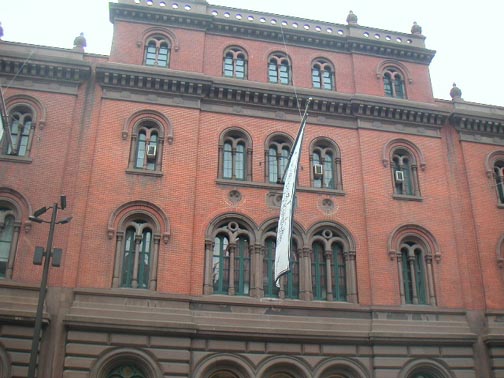 |
|
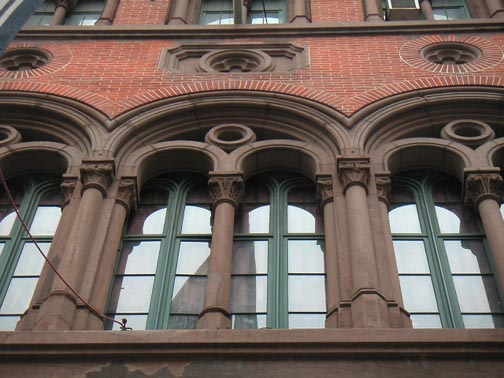 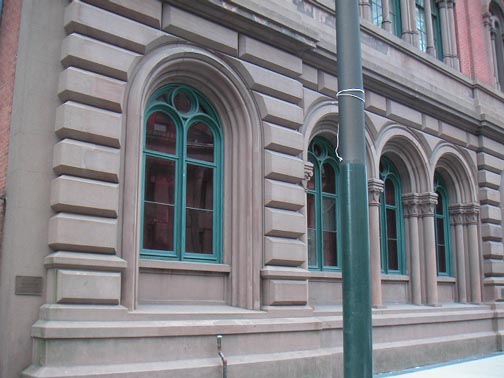 |
|
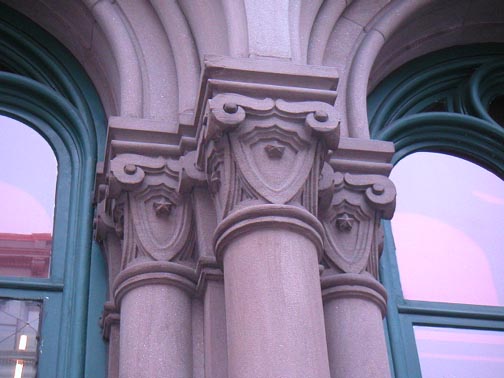 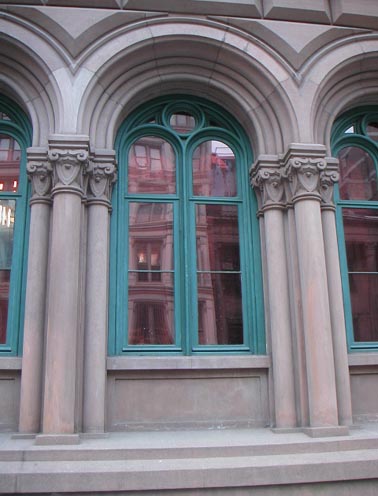 |
|
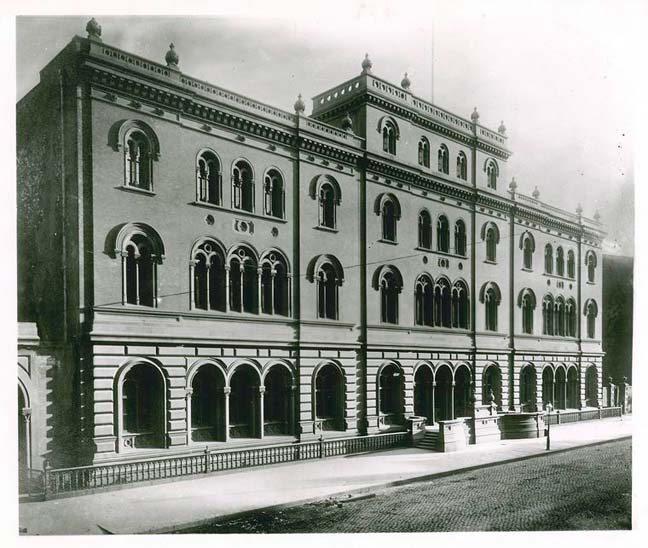 |
|
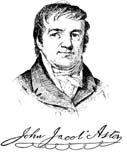 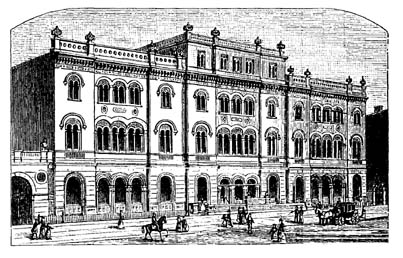 |
|
|
Joseph
Papp Public Theater
425 Lafayette Street, (between East Fourth
Street and Astor Place) An historical landmark and former site of the Astor Library, the Public Theater was saved from the wrecking ball by the legendary Joseph Papp to become home to six theaters, producing the best of original drama and comedy as well as new productions of timeless classics. Over the years, the Public has been responsible for the original productions of "Hair," "A Chorus Line," "The Normal Heart," "That Championship Season," The Joseph Papp production of "The Pirates of Penzance," and "Twilight Los Angeles 1994," amongst many others. Currently under the stewardship of Tony Award-winning director George C. Wolfe, the Public Theater offers theater-goers the opportunity to see the best of theater in an atmosphere as exciting and eclectic as the city that surrounds it. In a large, newly renovated lobby, audiences meet and mingle before and after their respective shows -- it has re-emerged as the cultural watering hole for the '90s and beyond. Also available is the film program -- "Film at the Public," a cutting edge series of the best of foreign and art-house cinema geared towards challenging the audience on many different levels. General Information Hours: Box Office: 1-7 pm daily, except
Monday 1-6 pm Manhattan Photography/Film/Video Theater John Jacob Astor indeed created a real estate legacy but his social standing in the city did not equal his wealth. His heirs proclaimed him a philanthropist by building the first wing of the Astor Library (the southern end) as a gift to the city--with strings attached. The arrival of German polytechnical graduates to America in the mid-19th century helped transmit the Round Arched Style to this country at this time. The Round Arched Style was an inexpensive but coherent and appropriate design for this this private/public building. Expanded twice since its original construction, the library is a rare surviving example of this style in NYC. John Jacob Astor
|
|
|
Streetscapes/The Old Astor Library, Now the
Joseph Papp Public Theater; Once It Held Many Pages; Now It Has Many
Stages By CHRISTOPHER GRAY Published: February 10, 2002, Sunday OPENED in 1854 as the Astor Library, the Joseph Papp Public Theater is both one of New York's oldest public buildings and a benchmark 1960's preservation project. Now, more than three decades later, the Public Theater has made progress upgrading the many elements that make up what has been a crucible for New York theater. But the completion of an ambitious $50 million master plan is not certain. Before the financier John Jacob Astor died in 1848, he worked with the book collector and librarian Joseph Green Cogswell to lay the groundwork, with a gift of $400,000, for a great public library. Within two months of Astor's death, the trustees -- including Cogswell, Washington Irving, the writer Fitz-Greene Halleck and Samuel Ruggles, the developer of Gramercy Park -- met to develop specific plans. The site was on the east side of what is now Lafayette Street, south of Eighth Street, at that time a distinguished residential address. Cogswell was able to acquire books cheaply during the unrest in Europe of the late 1840's, and the first building -- the southern third of what is now the Public Theater -- opened in 1854 with more than 80,000 volumes. The architect, Alexander Saeltzer, developed a wonderfully open two-story-high hall surrounded by gilded balconies and books arranged in double-height alcoves. But patrons had to apply to the librarians for access to the books. In a letter, Cogswell reflected on his decision to have closed stacks. ''It would have crazed me,'' he said, ''to have seen a crowd ranging lawlessly among the books, and throwing everything into confusion.'' In another letter, he said that the library was getting about 200 visitors a day. ''They read excellent books,'' he wrote, ''except the young fry, who employ all the hours they are out of school in reading the trashy, as Scott, Cooper, Dickens, Punch and The Illustrated News.'' The building was extended to the north (the present center section of the Public Theater) in 1859, and northward again in 1881. The additions echoed Saeltzer's design. There were early and frequent complaints about library policies, often directed at the Astor family. It was open during only daylight hours, and Frank H. Norton, writing in The Galaxy magazine in 1869, said that the hours excluded the working class and poor. ''The picture I have seen drawn by enthusiastic newspaper hacks of the rich capitalist and the mechanic sitting here side by side in honorable community of thought is agreeable, but also entirely fanciful,'' he wrote. THE library's policy of closed stacks and no loans was also much lamented. Those who favored tight controls pointed to patrons like the writer Richard Boyle Davy, who in 1872 tore 98 pages from an old volume of the Revue de Paris magazine to try to hide his plagiarism of one of its stories. In 1894, even after the library put some basic reference books on open shelves and granted stack access to some researchers, The New York Daily Tribune noted that the reader felt like ''an interloper and intruder'' against the librarians' longstanding ''reputation for churlishness and indifference.'' This sentiment was evoked again in 1897 when Jacob Friedman, a student at City College, removed nine books surreptitiously. He got the sympathy of Magistrate Henry A. Brann by saying he had taken them temporarily for classwork because his parents were too poor to buy them. Magistrate Brann repeatedly implored the library to drop its complaint, saying that a conviction would ruin the boy's life, but the library refused to budge. It soon developed, however, that the boy had given a false name and torn out the title pages with the library's stamp on them. It is not clear how his case ended. In 1898, after the Astor trustees agreed to become part of the new public library at 42nd Street and Fifth Avenue, The New York Times noted that the elegant old building ''seems today out of joint with its surroundings in the heart of the clothing trade.'' The reporter described the library as full of the idle, as well as professional ghost writers at work on articles, speeches and sermons, ''cavernous-eyed, shabby, male and female.'' After the Astor Library relocated, an organization now known as the Hebrew Immigrant Aid Society bought the building. Its architect, Benjamin Levitan, floored over the northerly and southerly double-height spaces and ripped out the elaborate iron and wood book stacks but left many of the columns, skylights, vaulted ceilings and other details. Even in its altered state, the interior contains some of New York's most remarkable Victorian spaces, although they are not designated landmarks. The society used the building as a receiving station, aid center, dormitory and synagogue for thousands of newly arrived immigrants. In 1965 the society sold the building to a developer who was about to demolish it when the Landmarks Preservation Commission, which had recently been established, stepped in for its first major victory. It arranged for the producer Joseph Papp's New York Shakespeare Festival to buy the building for $560,000 for an indoor complex to add to his existing success with outdoor performances of Shakespeare in Central Park. The architecture critic for The Times, Ada Louise Huxtable, called it ''the miracle on Lafayette Street.'' Mr. Papp, who died in 1991, hired Giorgio Cavaglieri to convert the building. Mr. Cavaglieri had been working on the conversion of what is now the Jefferson Market Courthouse in Greenwich Village into a library. He recalled that Mr. Papp had first wanted to put a 700-seat theater into the surviving double-height room in the center. But it was too expensive, and so he altered the space into what is now the Anspacher Theater, where the musical ''Hair'' opened in 1967 as the Public Theater's first production. In 1975, in the complex's Newman Theater, ''A Chorus Line,'' directed by Michael Bennett, opened before moving to Broadway for a 15-year run. The Public now has seven theaters in its building. Bob Foreman, the director of operations, said the Public has spent $12 million on projects like reconstructing the lower level of the old north hall, installing a mezzanine level for more dressing rooms and production support spaces. ''Audiences demand more realistic sets now,'' he said. Other theaters in the complex have been upgraded in recent years. Polshek Partnership Architects has developed a master plan for the Public Theater that calls for expanding the Anspacher Theater from 299 to 499 seats. That project, though, is a long way off. ''Even before Sept. 11 we thought in terms of a decade,'' Mr. Foreman said. Part of the plan is to rebuild the building's front stoop, to provide more space in the entrance hall. James Stewart Polshek said it also bothered him that ''there's nothing mediating the building face and the curb.'' ''Restoring the stoop,'' Mr. Polshek said, ''has long been a dream of mine.'' Published: 02 - 10 - 2002 , Late Edition - Final , Section 11 , Column 1 , Page 7 Correction: February 17, 2002, Sunday The Streetscapes column last Sunday, about the Joseph Papp Public Theater, which was once the Astor Library, referred imprecisely to the New York Public Library building at 42nd Street and Fifth Avenue. While the Astor's trustees indeed agreed in 1895 to become part of the public library, the 42nd Street building was not completed until 1911. Copyright New York Times. |
|
|
links |
|